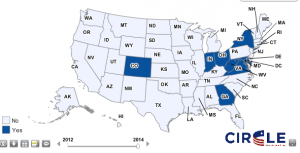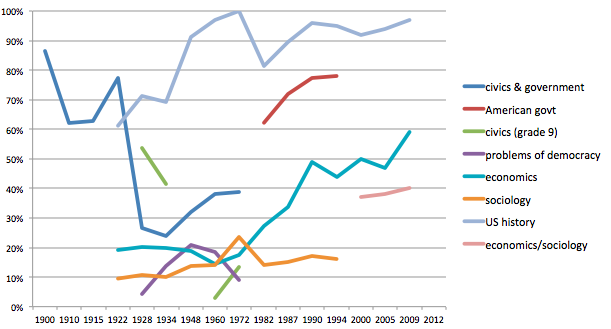(Boston’s Logan Airport) The new framework for AP US History is under fire for being too liberal, while students and teachers are walking out to protest a local Colorado history curriculum seen as too conservative. American “exceptionalism” is central to all these debates.
I think some schools, published curricula, and teachers want their students to develop a basically critical stance toward American history in order to yield certain political conclusions, such as a desire to remedy past wrongs or to constrain American power. I do not agree that these objectives are appropriate in a history class (for reasons I will get to below). Frederick Hess and Chester Finn write on the American Enterprise Institute’s blog that “Much of the criticism [of the AP framework] is hysterical and inaccurate . . . but not all of it. The critics make a legitimate case that the framework is ideologically slanted and infused with 21st-century progressivist bias.” It overlooks “America’s motivating ideals. … There’s little about economics that doesn’t feel caricatured or framed in terms of government efforts to combat injustice. Students are introduced to decade after decade of American racism and depravity, with little positive context for the nation’s foreign engagements or its success creating shared prosperity for tens of millions.”
I am not certain that actual AP instruction will play out this way, but if it does, I would share these authors’ concern.
But other critics reveal that their objective is as ideological as the progressives’, just from the opposite direction. In the National Review, Stanley Kurtz makes much of Thomas Bender’s influence on the AP Framework. Bender, he writes, “is a thoroughgoing critic of American exceptionalism, the notion that America is freer and more democratic than any other nation, and for that reason, a model, vindicator, and at times the chief defender of ordered liberty and self-government in the world.”
What kind of claim is this— that “American is freer and more democratic than any other nation”? It could be a hypothesis subject to investigation. We would need to define “democratic” and “free” and then look at comparative data. Many conservatives hold that the US is not a democracy but rather a republic (with strict limits on popular sovereignty), so it doesn’t seem likely that we will turn out to be the most democratic nation in the world–or even that we want to be. I suppose conservatives would point to a relative lack of economic regulation to support the claim that we are the “freest” nation. But I am not sure that regulation is more restrictive in other capitalist nations (especially if one uses Friedrich von Hayek’s criterion that regulation violates liberty when it is unpredictable and capricious), nor is economic freedom the only thing that matters. No other country comes close to ours in the proportion of people it imprisons–hardly a sign of freedom. Freedom House ranks the US in the top tier in overall freedom, but we have a lot of company there.
Or perhaps it is a moral premise that “America is freer and more democratic than any other nation.” This could be the basis for acting as the “chief defender of ordered liberty and self-government in the world.” I object both to making the study of history instrumental to any particular moral outcome and to the moral position implied in that sentence.
Donald Kagan is also a solid conservative, and his critique of debunking versions of American history is roughly similar to Kurtz. Yet he is an excellent historian (I was privileged to take a seminar with him a quarter century ago), and he takes pains to acknowledge that the valid goal of instilling love of country “does not require us to denigrate or attack any other country, nor does it require us to admire our own uncritically. . … In telling the story of the American political experience, we must insist on the honest search for truth; we must permit no comfortable self-deception or evasion, no seeking of scapegoats. The story of this country’s vision of a free, democratic republic and of its struggle to achieve it need not fear the most thorough examination and can proudly stand comparison with that of any other land.”
Ultimately, here is where I stand:
First, the study of history is not, and should not be, value-neutral. It is an investigation into human agency in its benign and evil forms, and it should support appropriate value-judgments. However, the question of whether the US is the best country in the world is not worthy of us. It reflects unnecessary insecurity. It implies that in order for us to love America, we first have to rate it above all other countries, which would be like assuming that in order to love our children, we must know that they score best in the world on some measure of excellence. Likewise, the question of whether America is fundamentally bad and dangerous is unhelpful. Valid moral questions are about particular institutions, events, movements, ideas, and people. If you add up all the results, you will surely get a mixed score for the nation as whole.
Second, history is an intellectual discipline that should not be harnessed to any ideological agenda. It is impossible to think about history value-neutrally, yet we can design inquiries in such a way that the value conclusions are not foreordained; facts that are unknown when we pose our research questions will influence our conclusions. We can introduce our students to that kind of inquiry and its fundamental norms (intellectual openness and responsibility to facts). History as an intellectual discipline is inconsistent with an a priori message that the US is either uniquely excellent or deeply flawed. For instance, the Colorado curriculum that says “Materials should promote citizenship, patriotism, essentials and benefits of the free enterprise system, respect for authority and respect for individual rights” is inconsistent with disciplined inquiry into our complex past.
We must also teach students to interact constructively and respectfully with fellow citizens who hold different views of American history. Such disagreements are inevitable because our overall opinions of the country are related to our religious and political commitments, which vary. Students should understand the variation. We ought to “teach the controversy.” Gerald Graff, the distinguished literary critic and former president of the Modern Language Association, wrote back in 1993:
One does not have to be a tenured radical to see that what has taken over the educational world today is not barbarism and unreason but, simply, conflict. The first step in dealing productively with today’s conflicts is to recognize their legitimacy. [We should] rethink the premise that the eruption of fundamental conflict in education has to mean educational and cultural paralysis. My argument is that conflict has to mean paralysis only as long as we fail to take advantage of it.
Finally, a “thorough examination” of American history (as recommended by Kagan) will yield compelling stories of grandeur, inspiration, tragedy, and pathos. Again, I would not use either a positive or a negative assessment of America as the premise of a history curriculum to which I would subject students. But my own reading leaves me thinking that our past is a remarkable combination of both. We have deep original sins of slavery and genocide and a record of extraordinary altruism and idealism. Our story is not as humane as, say, Canada’s, but it is an epic. If students get a whiff of the grandeur of American history and a strong sense that the moral verdict is not yet in, they may be motivated to help make our country the best it can be. If I had to sum up my own reaction to the drama of American history, it would be both loving and troubled, and it could even take the form of a palindrome*
America, you Jerusalem reborn!
No profligate, old-world, ruined people, you.
Behold: peace. You’re principle without pain and dishonor.
Dishonor and pain without principle: your peace.
Behold, you people: ruined world!
Old, profligate. No reborn Jerusalem you, America.
*Distantly inspired by Yehuda Alharizi’s “Palindrome for a Patron” [12th or 13th century] as translated by Peter Cole and cited by Harold Bloom in the June 28 New York Review of Books.
The post the new history wars appeared first on Peter Levine.



